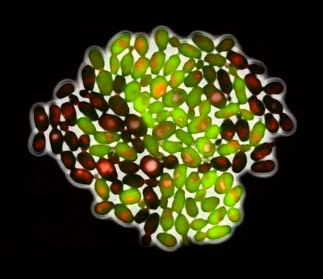Small World in Motion Honorable Mention Winner Highlight: Lu Bai

Posted on September 18, 2014
Anyone who’s enjoyed a glass of wine or fresh-baked bread can appreciate the amazing scientific properties of yeast. Yet for scientists such as Lu Bai, yeast is capable of so much more. Bai works with yeast to study gene expression, thanks to how much one can change its genetic content. In the world of genetic research, yeast allows means of experimentation that is much harder with human cells, fruit flies, and other samples.
Bai is Assistant Professor of Biochemistry and Molecular Biology and Assistant Professor of Physics at Pennsylvania State University. She is also one of the Honorable Mention winners of the Nikon Small World in Motion competition for her captivating video, “Budding Yeast.” In her video, we see how this amazing species shows genes expressing themselves in reproducing cells.
Aesthetically, the video is mesmerizing. In it, we see the yeast doubling and growing in size. It becomes hypnotic to watch as it takes on a new form with every new addition. But take a closer look, and like everything in the Nikon Small World universe, there is more than meets the eye.
Though the video is less than 30 seconds in length, what we’re actually viewing is a movie that took place over the course of 10 hours. Every time we see the yeast double (which happens every second of the video or so), we’re actually seeing is about 1.5 hours of real-time work. There is more to this technique than just speeding up the video, however. It’s hard to keep the environment for yeast to be “happy,” as Bai puts it. One has to maintain the environment for growth, while keeping the focus constant and the sample stage stable so the video comes out clearly.
Even more important is the green fluorescence we see in Bai’s video, highlighting the genes she is interested in studying. “All the cells you see here are from the same family: they originate from one ‘mother cell’ and grow from there, so genetically they are all the same,” Bai says. “At the beginning of the movie, we changed the yeast growth conditions, and the cells respond by ‘turn-on’ some genes, and one of them has green fluorescence. In other words, the green color in the cells represent their response to changing environment. If you look carefully, you will notice that different cells respond at very different time, some after two hours, and some after seven hours. In other words, the cells have ‘individuality’ and make different ‘decisions.’ This is the basis of both my research and fascination!”
Bai’s research is important, because in the human body, the same type of cells may also have different gene expressions, and it may sometimes cause disease - like cancer - for example. Understanding how and why individuality occurs, then, is the key to unlocking how to prevent them from occurring in the first place, if needed. To do this, her work involves characterizing the differences among cells, understanding if the individuality that occurs is good or bad, and trying to work out how the cells control these differences. Bai’s research is part of a larger body of work being done that hopes to uncover why these phenomenon take place. It can only be done studying cells one-by-one like we see here.
In Bai’s video, we see the work to solve one of modern science’s current mysteries. Her contribution to Nikon Small World in Motion showcases the best of the competition - a passion for science, shown through incredible research, and in a way that is aesthetically pleasing to the eye and that the general public can start to understand.
Bai says that while the scientific community started by studying yeast, they are working toward addressing similar questions in higher species. Simply put she says, “We are trying to understand the mechanism so that one day we can learn to control it.”
